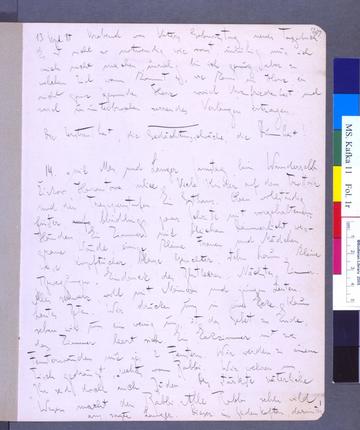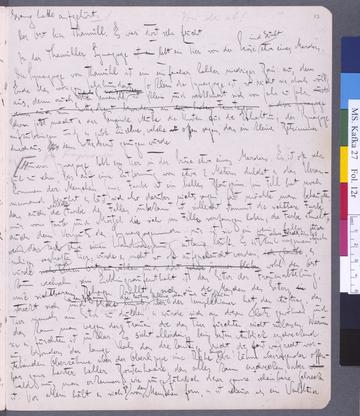Kafka and ‘Authentic Judaism’
Niamh Devlin holds a first-class MA (joint honours) in Philosophy/Theology & Religious Studies from the University of Glasgow and spent part of the summer of 2022 on a UNIQ+ research internship working with the Oxford Kafka Research Centre.
Kafka, a German-speaking assimilated Jew, living in turn-of-the century Prague, had a complex relationship with Judaism. Going through stages of ambivalence and occasional antipathy towards his

Diary entry detailing his encounter with the so-called wonder-rabbi of Grodek.
(c) Bodleian Library, University of Oxford - MS Kafka 11, fol. 1r
Jewish heritage and identity, Kafka became enkindled with Jewishness following his encounter with the Yiddish theatre troupe led by Yitzchak Löwy in 1911; a watershed moment in Kafka’s pursuit of Jewish cultural enrichment. Following this interaction, he emersed himself in the study of Yiddish and Hebrew, studied the Bible, and read Zionist newspapers and operated in Jewish-nationalist circles. Such active engagement with Judaism was underpinned by a search for a more ‘authentic’[1] form of Judaism that the Eastern European Jews, such as those in the theatre troupe, represented for him – something that was inherently different from the secular and sentimental Judaism imparted by his family. Accordingly, in order to understand Kafka’s fascination with Jewish culture, language, history, and politics post-1911, an understanding of this sense of ‘authenticity’ is required.
The Eastern European Jews embodied the ‘authentic’ Jewish tradition and identity that fascinated Kafka and others in the circle of Jewish intelligentsia of Prague. The Eastern Jews were descendants of those Jews who had left Germany in the Middle Ages, settling in self-contained communities across Poland, segregated from the rest of the population and their normative Christian culture. Following the great Russian famine and epidemic of 1868-69, these Jews embarked on a mass emigration, thus finding themselves continuing the diasporic tradition once again. While a very much condensed and abridged history, the central point here is that these Eastern Jewish communities, separate from gentile influence, represented an unadulterated and ‘pure’ form of Jewry. That is, they spoke Yiddish as their vernacular language, and Judaism was central to their everyday lives, leaving very little distinction between the sacred and the profane. Hence, the culture of the Eastern European Jews was very different to the assimilated Western Jews. The Western Jews of Prague encountered the Eastern Jews’ culture through the likes of the Yiddish theatre performances of which Kafka enjoyed and wrote about several times in his diaries and letters. The Western Jews, having undergone the processes of assimilation and modernisation, perceived the Eastern Jews as exotic and as exemplifying a pure primitivism which many Jews involved in Zionism desired to emulate (Spinner 18). They valued their maintenance of their own language and cultural identity and how they operated in distinct ethno-national communities (Nekula 62). Kafka, as an assimilated Western Jew, shared this notion of exoticism and idealism of the Eastern Jews. Stach claims that for assimilated modern Jews like Kafka, authenticity was “a seamless accord, free of outside interferences and catchphrases, an accord of thinking, feeling, and acting: harmony with oneself, and truthfulness” (118).

(c) Bodleian Library, University of Oxford - MS Kafka 27, fol. 12r
We can find characterisations of this ‘authentic Jewishness’ in Kafka’s writings, both his personal entries and fiction. Two significant texts in this domain include a diary entry from 14 September 1915 (Figure 1), and a lesser-known short story, ‘In Our Synagogue’ (Figure 2). The manuscripts of both of these fragments are held by the Bodleian Library at the University of Oxford. Though different in nature, both pieces capture Kafka’s perception of the quintessential ‘authenticity’ of the Eastern Jews that he held in much higher favour than his previous understanding of Western Jewry.
The diary entry reports Kafka’s venture to Žižkov with Georg Langer and his friend Max Brod in which they met the so-called ‘wonder-rabbi’; the Galacian, Hassidic Rabbi of Grodek (Spinner 21; Stach 107). Arriving during an unfamiliar Jewish religious custom (Shalosh seudos – the “Third Meal” of the Sabbath), Kafka recounts the event as an outsider, capturing it as alien and incomprehensible based on his ignorance of the customs. For example, he calls attention to the manner in which the rabbi eats the food from his hands: “Scratched in his beard, blew his nose through his fingers, reached into the food with his fingers”. This is emphasised in Brod’s Über Franz Kafka in which he recounts how Kafka described the event when they were travelling back home: “like being among a wild African tribe. Blatant superstition” (Stach 107). Reinforcing this sense of otherness, Kafka captures the rabbi’s appearance as novel and exotic by referencing his silk caftan and furred cap. And, echoing antisemitic stereotypes, he depicts him as dirty, particularly through references to his hair. This characterisation is reinforced through the inclusion of Langer’s description of the rabbi as a savage, as well as the dark, loud, and claustrophobic setting.
However, Kafka simultaneously highlights the rabbi’s spiritual purity through the ‘washed out’ imagery (“A pale, dim roomy, whiteish-grey walls”) and emphasis on his pale skin: “when you saw the whiteness of his skin, a whiteness such as you remembered having seen before only in your childhood imaginings – when one’s parents too were pure”. This serves as a strong juxtaposition between the previous dark and dirty imagery. This dichotomy between dirty and pure also appears in ‘In Our Synagogue’, highlighting the significance of this tension in Kafka’s perception and understanding of ‘authentic’ Judaism. Overall, Kafka casts the rabbi as a paternalistic yet pure figure of authority (an oxymoron for Kafka) and hence as a real source of intrigue and fascination.
Similar descriptions of the ‘authentic Jew’ can be found in one of Kafka’s lesser-known and often overlooked fragments, which is interestingly the only explicit reference to Judaism in his fiction: the text ‘In Our Synagogue’. The story considers an animal living in a certain synagogue. The animal is an uncomfortable presence, and the diminishing community, despite the fear and discomfort brought about by the creature’s occupancy, are made to downplay and repress its significance due to their inability to expel it. The animal is described with similar features as the rabbi in the previously discussed diary entry – as unattractive and old. The creature’s exoticism and dirty appearance are depicted through the descriptions of its “pale turquoise” fur, though only being so because of being covered in the dust and mortar from residing in the synagogue for an extended period. Despite this uncleanliness, the animal continues to enjoy its residence in the synagogue despite the desire of religious authorities to remove the creature, thus the tension between dirty and pure arises again. This is emphasised through the religious leaders’ desire to re-consecrate the synagogue. How can we make sense of this animal? The animal is cast as a knowledgeable creature who has survived many generations: “Does this old animal know more than the three generations that foregather in the synagogue each time?”. It stands out amongst the modern, westernised, assimilated Jewish community which has lost its sense of identity. In this sense, the animal, like the rabbi, can be said to embody the tenacity of an older, more ‘primitive’ but ‘authentic’ Judaism in modern culture. To sum up, during Kafka’s pursuit of an authentic Jewish culture, he constructs what can be seen as what Miron describes as a rather “banal binary” and dichotomy between Western and Eastern Jews (Miron chapter 9, paragraph 5.271). While he depicts these Orthodox communities as alien and potentially uncivilised, his texts also romanticise the authenticity of these Eastern Jews (Miron chapter 9, paragraph 2.71). While we need to be careful with terms like ‘authentic’ in general, and especially so in relation to protected minorities such as the Jewish community, understanding this notion of ‘authenticity’ perpetuated by the Western assimilated Jews in Kafka’s contemporary cultural sphere is critical. That is, understanding concepts such as ‘authentic Judaism’ provides a real insight into attitudes of Jewish identity in Kafka’s time, which helps us to contextualise his relationship with Judaism and associated movements such as Zionism.
[1] The potential problematics of a term like ‘authentic’ should not be ignored. Apart from the naivety in assumptions of such a dichotomy of East and West, the term may be appropriated in dangerous (antisemitic, discriminatory, etc) ways. However, the usage of ‘authentic’ here is to demonstrate the kind of understanding that Kafka and others in the Jewish intelligentsia of Prague, specifically, had of the term, rather than an objective description.
Works Cited:
Kafka, Franz. The Diaries of Franz Kafka, 1910-23. Edited by Max Brod. London: Minerva, 1992.
Kafka, Franz. The Burrow: Posthumously Published Short Fiction. Translated by Michael Hofmann. London: Penguin Modern Classics, 2017.
Miron, Dan. The Animal in the Synagogue: Franz Kafka’s Jewishness. Translated by Yitzhak Lewis. Lanham, MD: Lexington Books, 2019.
Nekula, Marek. Franz Kafka and His Prague Contexts: Studies on Language and Literature. Prague: Karolinum Press, 2016.
Robertson, Ritchie. ‘Western Observers and Eastern Jews: Kafka, Buber, Franzos.’ The Modern Language Review, vol. 83, no. 1. (1988): 87–105.
Spinner, Samuel J. ‘Plausible Primitives: Kafka and Jewish Primitivism.’ The German Quarterly 89.1 (2016): 17-35.
Stach, Reiner. ‘What do I Have in Common with Jews?’ In Kafka: The Years of Insight. Princeton: Princeton University Press, 2021, 105-128.


